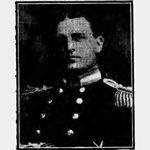Commemorated: | |||
| 1. Memorial: | Plymouth Naval Memorial, Devon | 1 | |
| 2. Book: | The (1921) Masonic Roll of Honour 1914-1918 | Pg.123 | |
| 3. Memorial: | The (1940) Scroll - WW1 Roll of Honour | 42B GQS | |
Awards & Titles: | |||
Early Life :
De Ruvigny's: GEDGE, JOSEPH THEODORE Staff Paymaster, R.N. eldest s. of the Rev. Edmund Gedge, of the Rectory, High Street, Shadwell, E., late Vicar of Marden, Hereford, by his wife Mary Elizabeth, dau. of the late Norman King, of Great Barton Place, Bury St. Edmunds, J.P.; and brother to Lieut. P. Gedge (q.v.); b. 27 March, 1878; educ. at St. John's School, Leatherhead; entered the Navy 1897, receiving his seniority 1911; was appointed to H.M.S. Amphion in Dec. 1912, and was drowned 6 Aug. 1914, when that ship struck a mine in the North Sea, being the first British officer in either service, to fall in the war; unm.Service Life:
Campaigns:
- The First World War 1914-1918, World-wide.
| Unit / Ship / Est.: HMS Amphion |
HMS Amphion was an Active class scout cruiser that became the first British warship to be lost during the First World War. At the start of the war she was the leader of the 3rd Destroyer Flotilla, based at Harwich. On 5 August 1914 the Harwich force put to sea to conduct a sweep of the Heligoland Bight. A trawler crew informed the captain of the Amphion that they had seen a ship dropping suspicious objects overboard. On investigation this tuned out to be the German minelayer K?nigin Luise, a small Hamburg-Amerika liner of about 2000 tons. The KONIGIN LUISE, an auxiliary vessel of the German Navy resembled one of the British steamers that had been on the service between Harwich and the Hook of Holland.The Amphion and her flotilla give chase, sinking her by noon on 5 August not far from Orfordness. The Amphion picked up the survivors and continued with her sweep. German survivors stated that many mines were still aboard her. They further asserted that she had laid a long line of mines from a position in lat. 52 10' N., long. 2 25' E., to the eastward. This position is about thirty miles to the eastward of Orfordness, and it is clear enough that such mines were laid for the express purpose of sinking any British forces proceeding from Harwich towards Germany. At 6.30am on the following morning (6 August), the Amphion hit one of the mines laid by the K?nigin Luise. The order to abandon ship was given, but she then hit a second mine, and sank so quickly that 148 of her crew and most of the German prisoners were lost. The first masonic casualtiers of the war died on HMS Amphion- Brothers DEACON and GEDGE, both from lodges based in Devon. Sources: Daring deeds of merchant seamen in the great war - Wheeler, Harold F. B 1918 The merchant navy (Volume 1) - Hurd, Archibald, Sir http://www.historyofwar.org/articles/weapons_HMS_Amphion.html |
| Action : HMS Amphion, Sinking of |
HMS Amphion was an Active class scout cruiser that became the first British warship to be lost during the First World War. At the start of the war she was the leader of the 3rd Destroyer Flotilla, based at Harwich. On 5 August 1914 the Harwich force put to sea to conduct a sweep of the Heligoland Bight. A trawler crew informed the captain of the Amphion that they had seen a ship dropping suspicious objects overboard. On investigation this tuned out to be the German minelayer Koenigin Luise, a small Hamburg-Amerika liner of about 2000 tons. The KOENIGIN LUISE, an auxiliary vessel of the German Navy resembled one of the British steamers that had been on the service between Harwich and the Hook of Holland. The Amphion and her flotilla give chase, sinking her by noon on 5 August not far from Orfordness. The Amphion picked up the survivors and continued with her sweep. German survivors stated that many mines were still aboard her. They further asserted that she had laid a long line of mines from a position in lat. 52 10' N., long. 2 25' E., to the eastward. This position is about thirty miles to the eastward of Orfordness, and it is clear enough that such mines were laid for the express purpose of sinking any British forces proceeding from Harwich towards Germany. At 6.30am on the following morning (6 August), the Amphion hit one of the mines laid by the Koenigin Luise. The order to abandon ship was given, but she then hit a second mine, and sank so quickly that 148 of her crew and most of the German prisoners were lost.
The first Masonic casualties of the war died on HMS Amphion - Brothers DEACON and GEDGE, both from lodges based in Devon. Sources: Daring deeds of merchant seamen in the great war - Wheeler, Harold F. B 1918 The merchant navy (Volume 1) - Hurd, Archibald, Sir http://www.historyofwar.org/articles/weapons_HMS_Amphion.html
Masonic :
| Type | Lodge Name and No. | Province/District : |
|---|---|---|
| Mother : | Sir Francis Drake No. 2649 E.C. | Devonshire |
Initiated | Passed | Raised |
12th June 1912 | 11th December 1912 | 8th January 1913 |
Source :
The project globally acknowledges the following as sources of information for research across the whole database:
- The Commonwealth War Graves Commission
- The (UK) National Archives
- Ancestry.co.uk - Genealogy, Family Trees & Family History online
- ugle.org.uk - The records of the United Grand Lodge of England including the Library and Museum of Freemasonry
Additional Source:
- Founder Researchers : Paul Masters & Mike McCarthy
- Researcher : Bruce Littley

